As hunters, we are morally and ethically obligated to harvest our deer as humanely as possible.
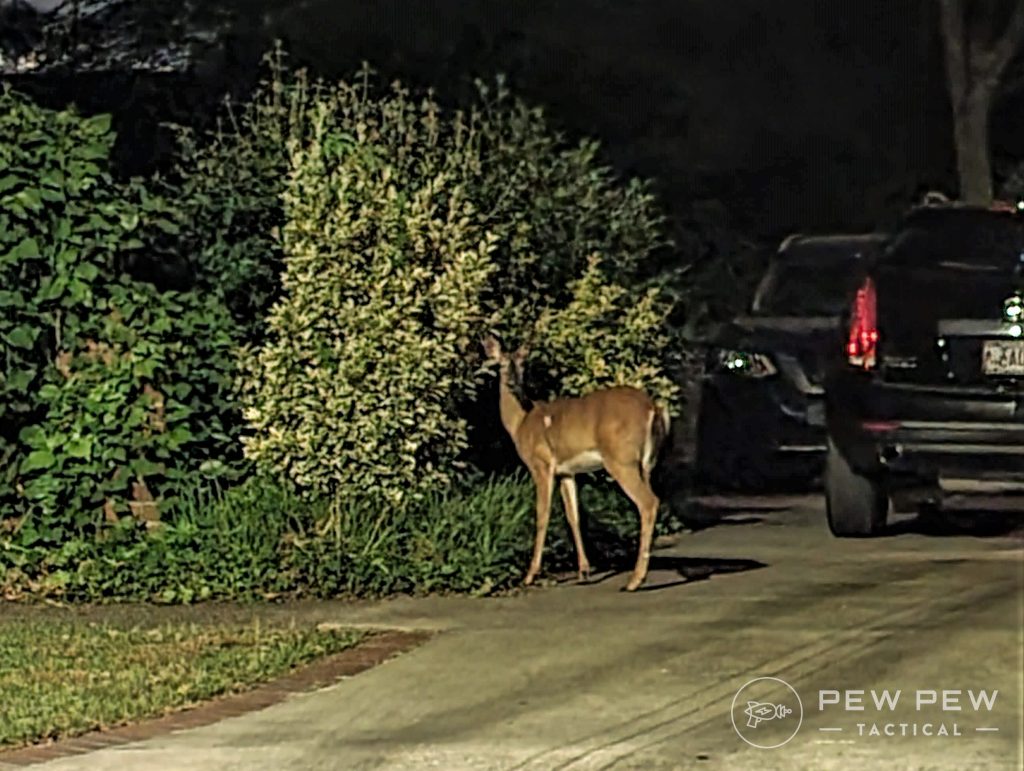
How do you actually make sure your shot quickly and humanely harvests your deer?
We’ll cover that and more.
Anatomy Lessons
First and foremost you need to educate yourself a bit on deer anatomy. Most people are surprised by the fact that the heart is so far forward and so low in the chest cavity.
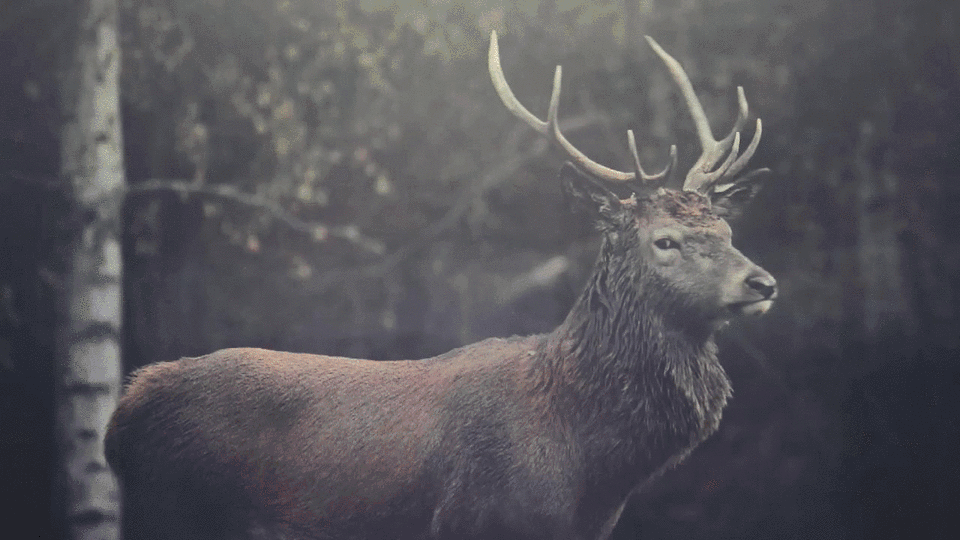
One helpful resource for the North American Hunter is Craig Boddington’s book: “The Perfect Shot, North America: Shot Placement for North American Big Game.”
-
25% off all OAKLEY products - OAKLEY25
Copied! Visit Merchant
Another helpful tool at the range is a life-size target of your chosen game with the internal anatomy drawn onto the target like the ones available at Pistoleer.com.
Finally, if you’re looking for a more semi-permanent method of practicing – MK Machining makes a great line of water-jet cut AR500 steel targets with life-size deer and elk vitals along with life-size coyote and javelina targets.
You learned the ABC’s (Airway, Breathing, Circulation) in your Red Cross First Aid Class. When we damage or compromise any of the same systems on a deer with a bullet the likely outcome is a dead deer.
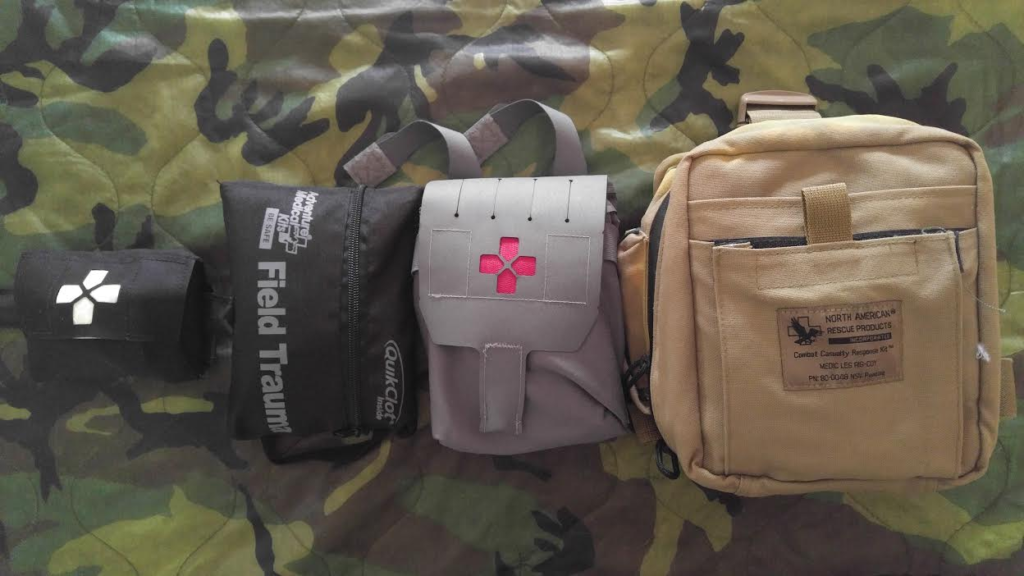
The airway and breathing system’s largest organ is the lungs. If the lungs are damaged or compromised, then oxygen levels suffer. If not enough oxygen reaches the brain the bodily systems begin to shut down.
In addition, if there are holes in the lungs massive internal bleeding occurs because the entire blood supply passes through the lungs to expel carbon dioxide and to re-oxygenate the blood.
When we think circulation, we think heart. The heart muscle is necessary to pump freshly oxygenated blood to the brain, organs, and muscles. If the heart is damaged, pumping efficiency drops and eventually the animal will die.
In almost any hunting scenario a shot to the heart/lung region is the most ethical, is likely to result in a quick death, and presents the biggest target we can aim at on a deer-sized animal.
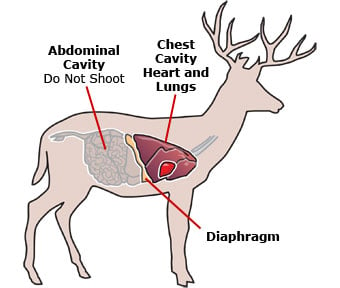
The other areas that will result in a quick harvest are the brain and the spinal column.
The brain controls the body. In most cases, traumatic damage from a shot to the brain means instant death.
Likewise, the spinal column carries all the signals from the brain to the organs and muscles of the animal.
If the signal is disrupted, bodily functions are compromised and likely the animal is quickly disabled, paralyzed or killed.
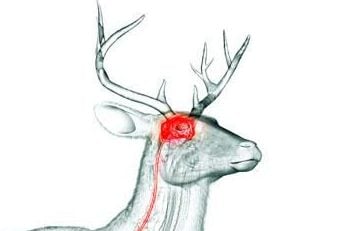
However, since both the spine and the brain are much smaller and harder to hit than the lungs and heart – you should almost ever aim for these spots.
Behind the heart/lung area lies the liver, stomach, and intestines. While a shot to this area will sometimes kill, it is not recommended.
Furthermore, any shot through the “guts” can potentially contaminate meat and if you do recover the deer, the field dressing job will less than pleasant.
Where To Shoot A Deer
Shot Placement
There is no substitute for good shot placement. Whether you shoot a .30-06 or a .375 H&H Mag, if you don’t hit vital organs, you won’t consistently or reliably harvest deer.
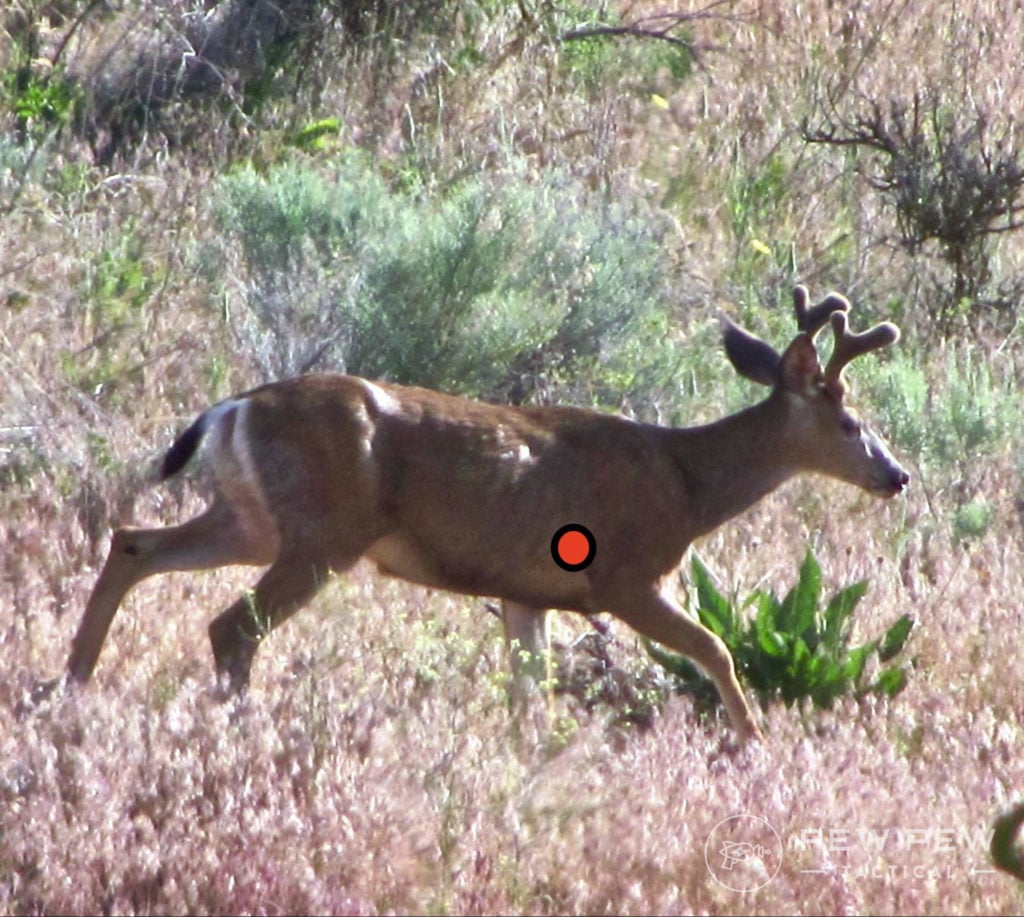
A bigger cartridge may allow you to make a hard quartering away shot that you wouldn’t take with a lesser cartridge or a lighter bullet. That is only because the bigger cartridge will give you the penetration needed to get through ribs and paunch to reach the vital organs.
When in doubt, don’t take the shot unless you know for certain you can hit the lungs or the heart.
1. Broadside Shot
Ideally, every deer will stand perfectly broadside to you and have their onside front leg stepped forward just a bit. This gives you the best possible shot. The little crease right behind the front leg and about 1/3 of the way up from the brisket will produce a killing shot nearly every time.
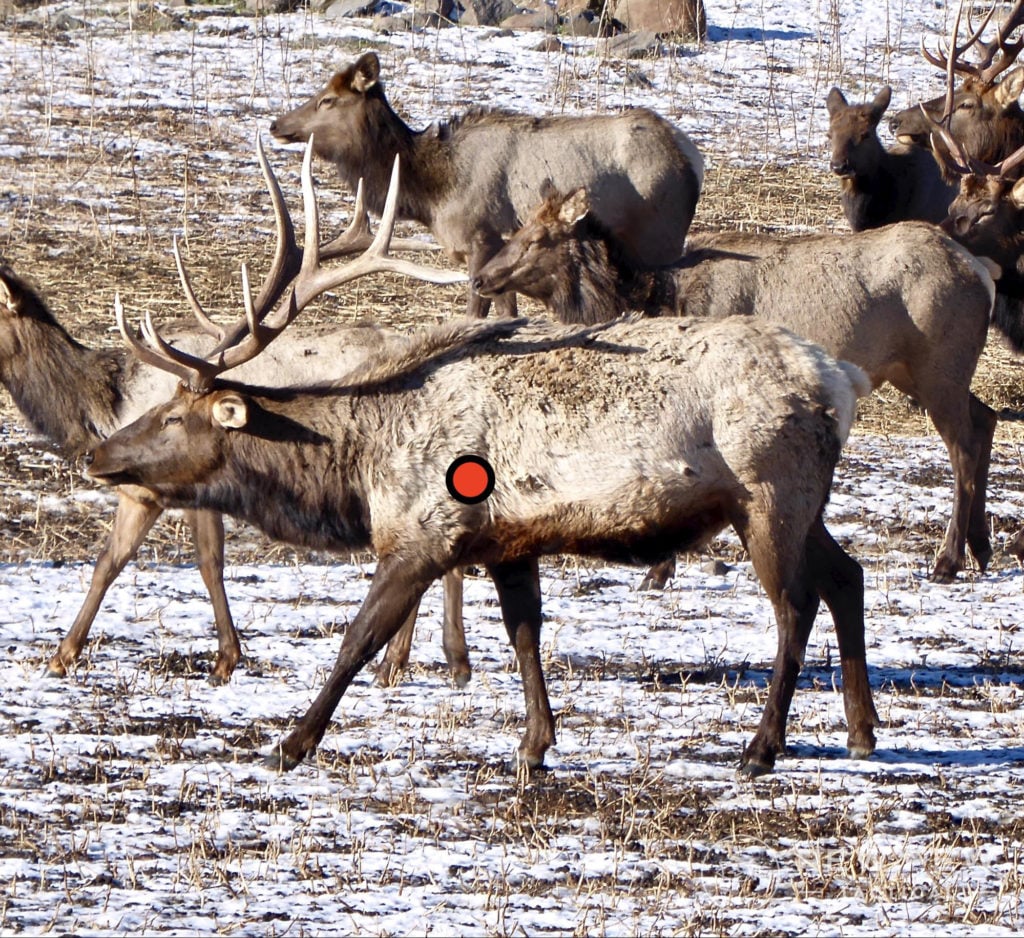
Most likely this shot will go through the heart and damage both lungs. This shot also gives you some margin for error to the front and back by a couple of inches as well as a little margin if you shoot high. There is not a lot of area if you shoot low, so be careful here.
To err on the side of caution, you can hold a bit higher, between one-third and one-half way up from the brisket on a line with the rear of the front leg. This shot will normally be above the heart but will cause massive damage to both lungs.
Something to keep in mind with regards to lung shots. The higher the hit, the less blood you are likely to see on the ground immediately. The holes in the lungs are higher on the body and the lungs and chest cavity will take longer to fill with blood, so you may not see an immediate blood trail from this shot. If you know you made a good hit, watch where the deer runs and give it a few minutes. You’ll find your deer down in very short order.
2. Quartering To Shot
If your deer is angling or quartering toward you a good shot is possible. Picture a softball or cantaloup hanging from a string in the deer’s chest.
Remember, it’s pretty low in the brisket, and roughly between the front legs.
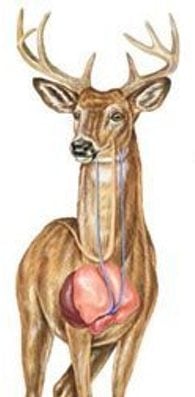
Pick your aiming point to go through the front point of the near side shoulder, through the heart and angling back toward the last rib. This path will very likely take the top of the heart out and parts of both lungs.
Be aware, if you are shooting a heavy rifle you bullet pay penetrate through to the stomach or intestines. The deer will suffer a fatal wound in the vitals, but you may have to contend with some perforated guts.
If the deer is coming straight on, this is another good shot. You will see a seam in the hairline from each front leg coming together in the center of the brisket.
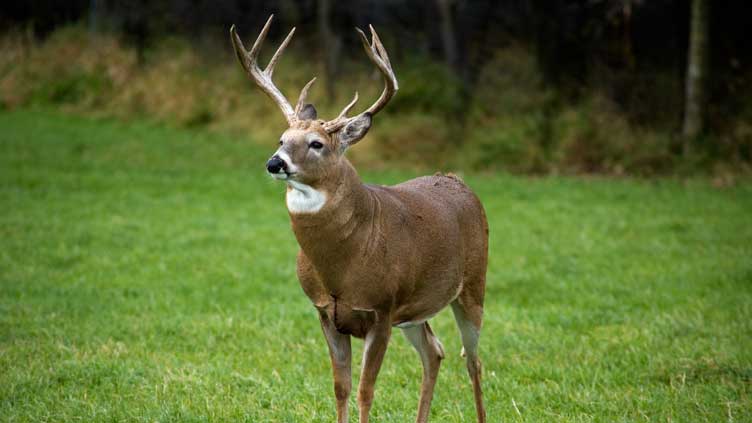
Hold dead center about four inches or so up from the hairline and you will center punch the heart. This shot can also drive through the chest cavity into the paunch, but your deer will literally never know what hit them.
I shot a blue wildebeest head-on with a 7×57 Mauser a few years ago and it was an amazingly effective shot. The wildebeest bucked a few times then literally fell over dead. The bullet was recovered from the ham after traveling through about four feet of critter.
3. Quartering Away Shots
Quartering away shots mean you need a bullet and cartridge capable of good penetration.
Now your deer is walking away from you. Again, visualize a softball hanging in the center of the deer’s chest. If you aim at the spot behind the shoulder, you will likely get a bit of lung, but not much because your bullet is traveling at an angle through the deer.
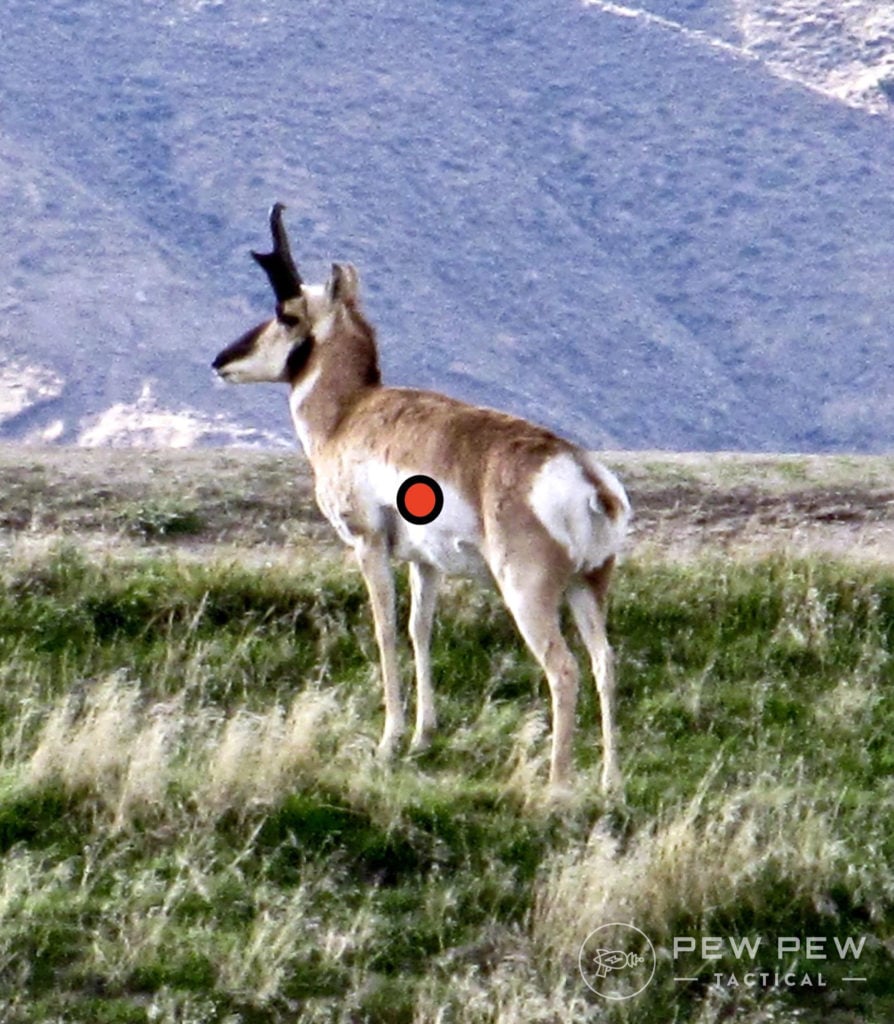
Instead, see where the line is that bisects the softball. You will very likely be holding near or even behind the rib cage depending on the angle.
Your bullet will pass through some of the paunch on it’s way to the heart and lungs. Likely the bullet will exit someplace forward of the offside shoulder.
4. Texas Heart Shot
This is the shot for the deer walking directly away from you. A shot right at the base of the tail, if the deer is on level with you can be very effective.
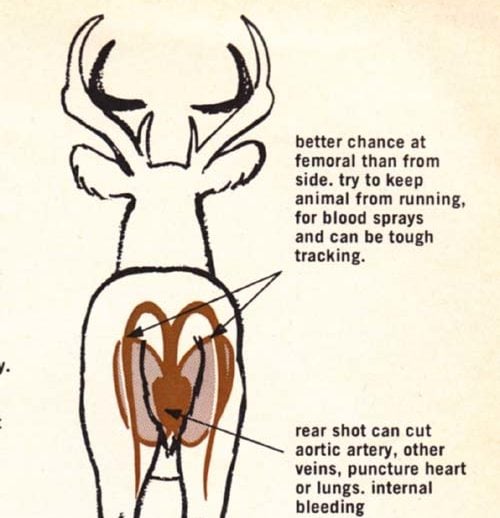
The bullet will travel right beneath the spine and straight to the tops of the lungs. Often there will be severe damage to the spinal column as well.
You need a bullet that will hold together and penetrate deeply to make this shot work. If you miss a little to either side of dead center you will damage a lot of meat in the hindquarter.
If you miss low or the animal is not on level with your shot you will shoot through the paunch.
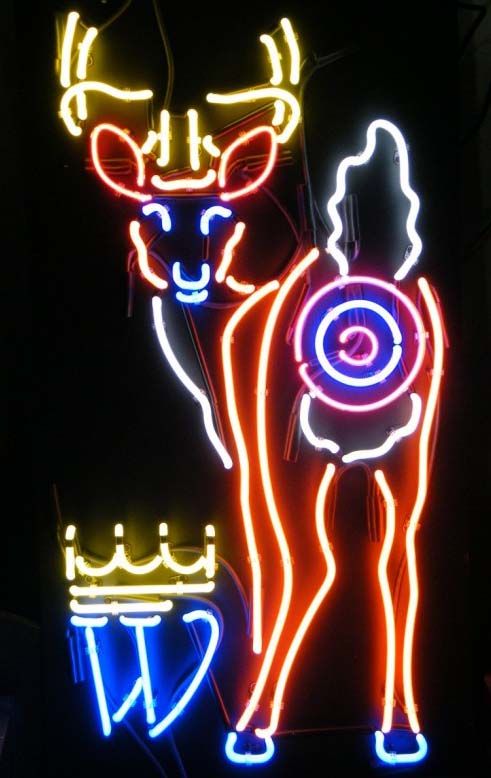
So it comes with some risk, but it can work out quite nicely.
My dad once shot a mule deer in this fashion. The deer was trying to sneak away and had it’s head down as it walked through the sage.
The bullet entered the anus, traveled all the way through the deer and exited the nostril.
It dropped in its tracks and technically didn’t have any entrance or exit wounds.
5. Headshots
The headshot will end your deer. It is a small target and if missed you will likely wound a deer you will not recover and that will just become food for the coyotes.
Every year many deer have their jaw or nose shot off by someone trying to make a headshot to “save” meat.
Unless you are very close, have a very precise rifle, on a very steady rest, pass on the headshot.
Not to mention the truly shocking sight that will greet you when you walk up to a head-shot deer.
6. Neck And Spine Shots
These shots are also best left alone. The spinal column is very narrow and a miss high or low usually means a wounded animal.
In some cases, a shot near the spine will momentarily stun and drop an animal. They will then recover and run off much to your surprise.
I made a hasty shot on a gemsbok who was standing broadside about 90-yards away. I pulled my shot and hit high.
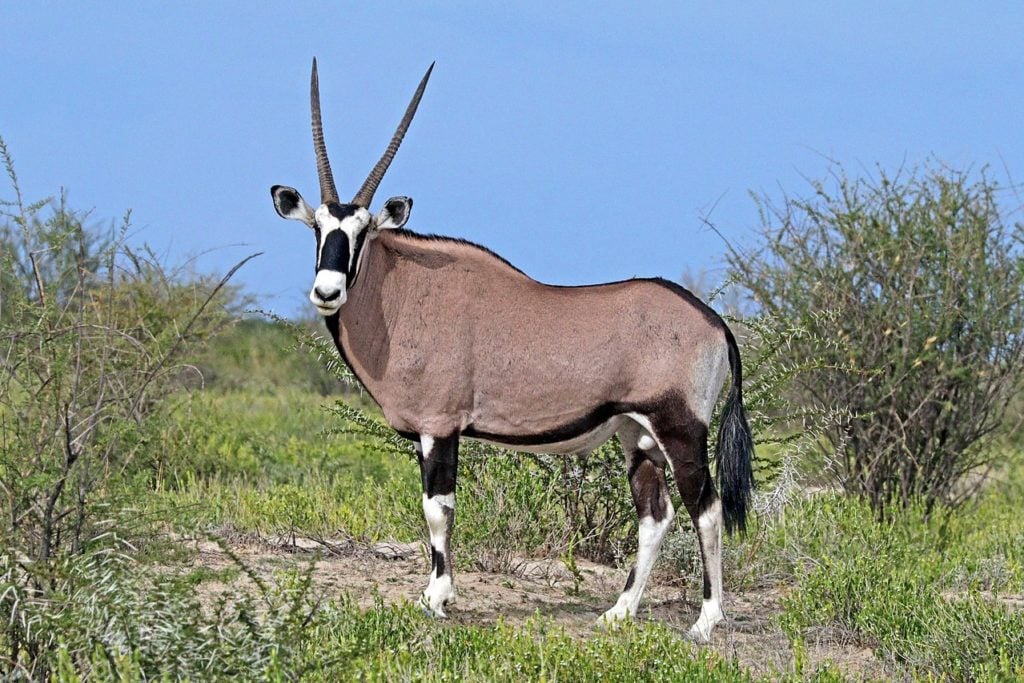
The gemsbok dropped like a rock. But by the time I had chambered a fresh round and grabbed the shooting sticks he was gone.
The bullet had hit above the lungs, but just below the spine, so it bled very little and just poked a hole through the muscle. I then spent the rest of that day and the next two days of my safari tracking and trying to kill that gemsbok.
It ended well enough but taught me an important lesson: shot placement rules.
The Bottom Line
For me, the center of the chest as close to broadside as possible is the shot I will wait for. I know if I make a good shot the deer will expire very quickly. I have some margin for error in each direction if my shooting is not perfect.
-
25% off all OAKLEY products - OAKLEY25
Copied! Visit Merchant
Yes, I may have to track my deer little ways, but the end of the tracking job is always predictable; a notched tag and venison in the freezer.
Study pictures of deer and invest in the Perfect Shot book so you know where to hold when the opportunity presents itself.
-
25% off all OAKLEY products - OAKLEY25
Copied! Visit Merchant
Grab some of the illustrated targets and head to the range and shoot from field positions. Can you reliably hit the vital zone when not shooting from the bench?
If not, you need to put in some time shooting from kneeling, and sitting, and resting on your pack. I have never once seen a bench out in the woods.
Learn where your rifle sends the first shot when the barrel is cold and clean. You may be surprised to learn that it hits differently than if the barrel has had a fouling shot fired.
That difference in point of impact is the difference between a harvest and a wounding shot or miss, especially as the range increases.
Bottom line: shot placement counts!
Tell us about your hunting adventures and the shot you like best for your big game hunting! If you liked this article, take a look at our Introduction to Deer Hunting and Best Beginner Hunting Rifles










5 Leave a Reply
Was surprised at the negative response to the neck shot about 3-6 inches from the head/ about 2/3 up from the bottom of the neck. Out of all the deer I have hunted, only one didn't drop and die immediately from neck shot. It either gets their spinal column or their jugular. I hit a heart with two lungs last year and it ran about 50 yards before dropping. I believe the neck is more humane. And if I make a bad shot and miss, Bambi goes free. No suffering.
Ditto. I've only had one deer that was still living after a neck shot. And the lung shots run up to 75+ yards. The adrenaline released during this last moments of the deer's life cannot be good for the meat.
In the last picture, the Savage Model 99 .300.
Tell us more about that scope mount!
Texas Heart Shot.....you'll only do that ONCE!!
No, I don't think I'll try it once at all. Too much risk for wounding, increased suffering and ruining the meat.